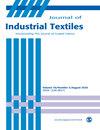Interaction of material- and structural elasticity – an approach towards a physiological compliance in small-caliber vascular grafts
IF 2
4区 工程技术
Q1 MATERIALS SCIENCE, TEXTILES
引用次数: 0
Abstract
Research purpose: The low patency rate (less than 50% at a 5-years follow-up) of commercial vascular grafts is strongly associated with compliance mismatch between graft und native artery. To address this deficit, we investigated the influence of the material and structural elasticity on the compliance behavior of small caliber vascular graft gaining for a stress-strain behavior adapted to the native vessel. Material & Methods: By combining different thermoplastic polycarbonate urethanes (TPU) fibers with different elasticity and non-elastic polyvinylidene fluoride (PVDF) fibers in different warp knitted tubular textile structures, we incorporate material and structural elasticity in a vascular graft (I.D. < 6 mm). The evaluation of the tubular fabrics is performed by determining the compliance properties in a mean pressure range between 20 and 120 mmHg by tensile testing. Results: We identified the draw ration of the TPU fiber production, the stitch course density of the fabric and the thread tension of the TPU yarn during the warp knitting process as statistically highly significant effects ( p < .005) on the compliance. With an adapted setting of those parameters, we were able to improve the compliance of the textile vascular grafts over the entire physiological pressure range (20–120 mmHg) by 400–630 % compared to current clinical ePTFE (expanded polytetrafluoroethylene) grafts towards native vessels. Conclusion: By combining material and structural elasticity in a warp knitted textile structure, we were able to biomimic the compliance towards physiological properties. Our approach can be seen as blueprint to adapt elasticity properties in other implant applications.材料和结构弹性的相互作用--实现小口径血管移植物生理顺应性的一种方法
研究目的:商用血管移植物的低通畅率(随访 5 年时低于 50%)与移植物和原生动脉之间的顺应性不匹配密切相关。为了解决这一问题,我们研究了材料和结构弹性对小口径血管移植物顺应性行为的影响,以获得与原生血管相适应的应力-应变行为。材料与amp;方法:通过将不同弹性的热塑性聚碳酸酯聚氨酯(TPU)纤维和非弹性的聚偏二氟乙烯(PVDF)纤维结合到不同的经编管状织物结构中,我们在血管移植物(内径 6 毫米)中加入了材料和结构弹性。通过拉伸测试确定管状织物在 20 至 120 mmHg 平均压力范围内的顺应性,从而对其进行评估。结果:在经编过程中,我们发现热塑性聚氨酯纤维生产的牵伸率、织物的针迹密度和热塑性聚氨酯纱线的线张力对顺应性有非常显著的影响(p <.005)。通过调整这些参数的设置,我们能够在整个生理压力范围(20-120 mmHg)内将纺织血管移植物的顺应性提高 400-630%,而目前临床上使用的 ePTFE(膨体聚四氟乙烯)移植物与本地血管相比,顺应性提高了 400-630%。结论通过在经编纺织品结构中结合材料和结构弹性,我们能够模拟生物顺应性,使其符合生理特性。我们的方法可被视为在其他植入应用中调整弹性特性的蓝图。
本文章由计算机程序翻译,如有差异,请以英文原文为准。
求助全文
约1分钟内获得全文
求助全文
来源期刊

Journal of Industrial Textiles
MATERIALS SCIENCE, TEXTILES-
CiteScore
5.30
自引率
18.80%
发文量
165
审稿时长
2.3 months
期刊介绍:
The Journal of Industrial Textiles is the only peer reviewed journal devoted exclusively to technology, processing, methodology, modelling and applications in technical textiles, nonwovens, coated and laminated fabrics, textile composites and nanofibers.
 求助内容:
求助内容: 应助结果提醒方式:
应助结果提醒方式:


